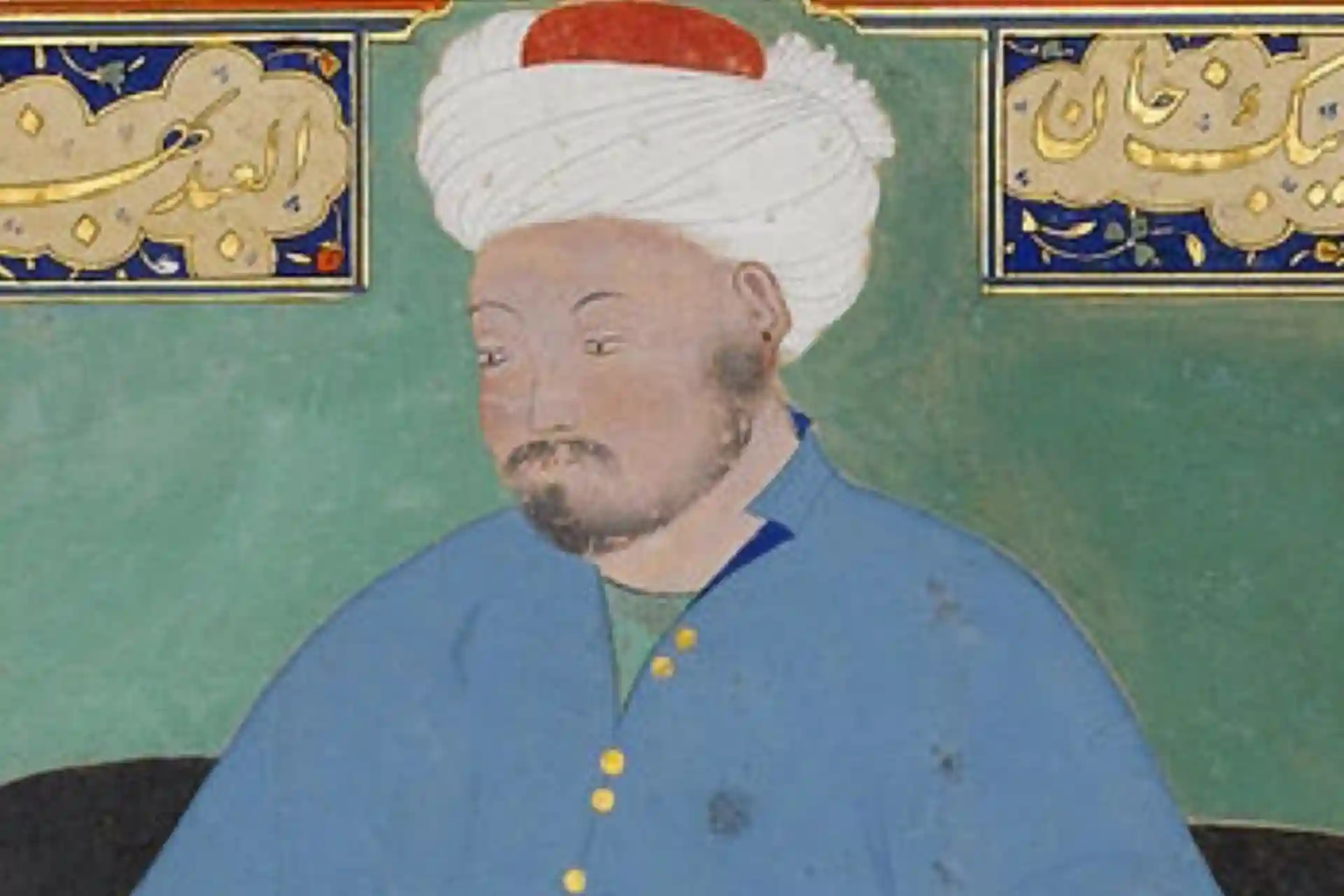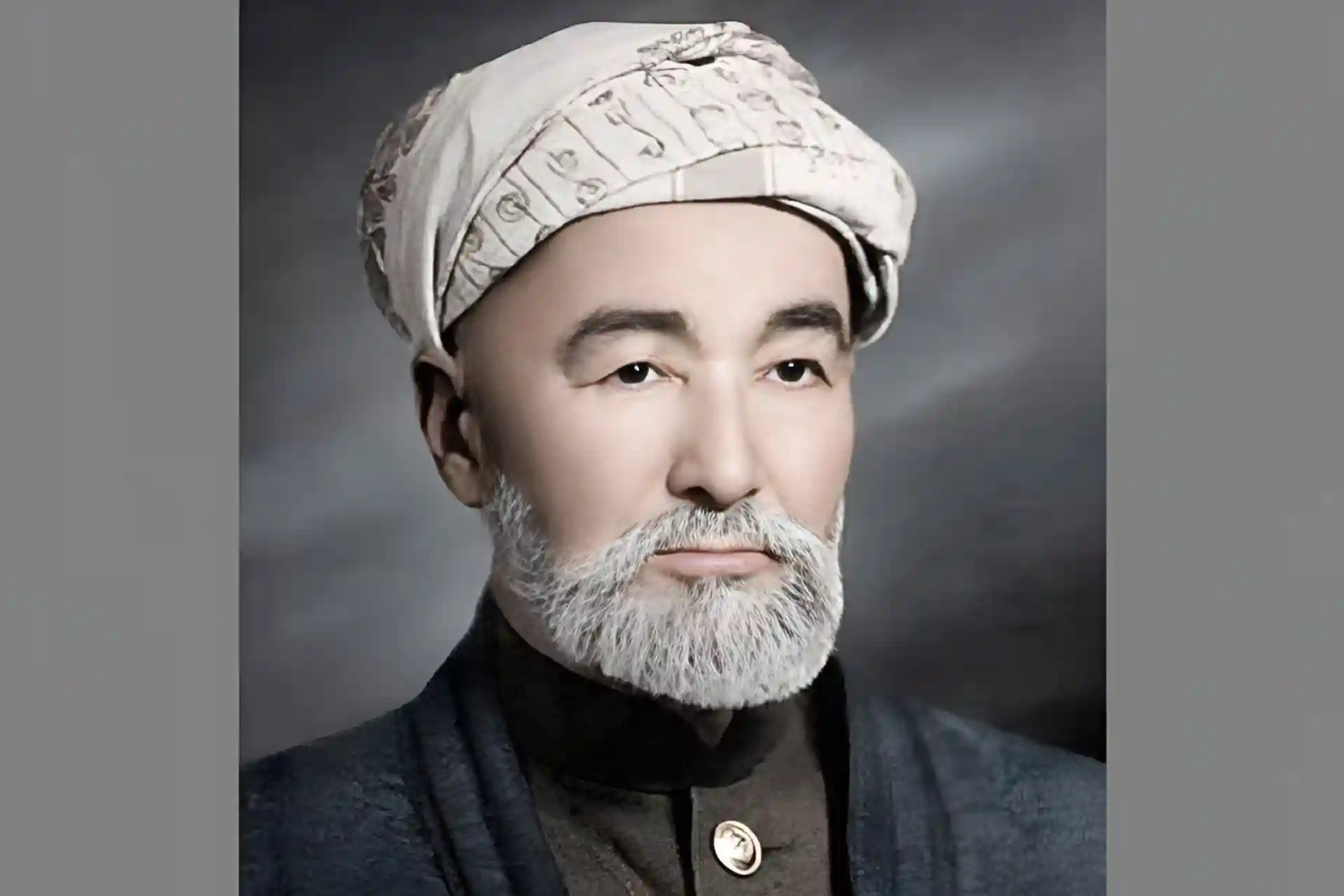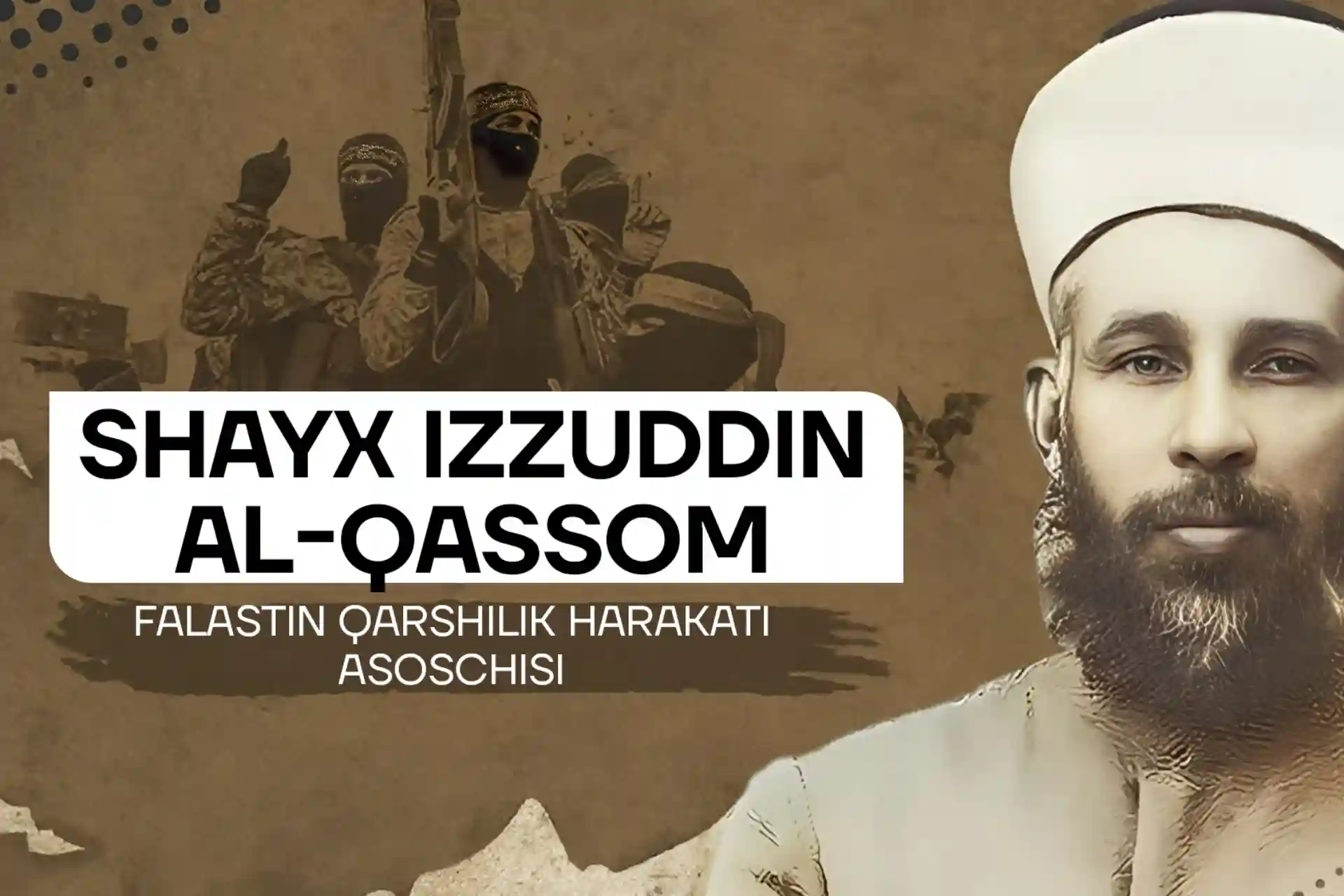Uzbek's "step" ancestor is Muhammad Shaibanikhan
He was born in 1451. His name was Muhammad, and he was known by the title of Shaibani Khan (Shiban Khan, Shaibaq Khan [Sheybek] Khan, Shah Bakht Khan, Shahi Beg Khan) in honor of Shiban, (Arabized form Shayban), son of Kuchi, the eldest son of Genghis Khan. His father's name is Shah Budak, and his mother is Aqqozi Begim, one of the Kalmyk princesses. After his father was killed by the Mongol Khan Yunus Khan and his grandfather Abulkhair Khan also died in the same year, he left Dashtikipchak with his brother Mahmud under the protection of Otabek Uygur Khan and Amir Karachin Bek; He went to Astrakhan (Ashtar Khan) and took refuge in Kasim Khan's house. Then he moved to Bukhara under the rule of Ahmad Mirza from the Timurids. He studied in Bukhara madrasas, studied Arabic and Persian languages. He established close relations with Yassaviya and Naqshbandi sheikhs. Then he returns to Dashtikipchok; He occupied cities such as Arkuk and Sighnoq (today the ruins of the Kurgan Altar) on the banks of the Syr Darya River. In 1488, Chigatai Khan entered the service of Mahmud, and in return for his success, he was given a homeland in Turkestan (Yassi).
Shaibani Khan, who increased his influence and power here, organizes a trip to Khorezm under the rule of Husayn Boykara, but there is no result. Then the Kazakh Khan starts a war with Burunduk (Barandak). He defeats Burunduk Khan and besieges the city of Urganch (Khiva). In the meantime, the people of Sabron revolted and appointed Shaibani Khan's brother Mahmud as the governor, but when the Kazakhs arrived, Mahmud left the city and joined Shaibani Khan.
Taking advantage of the turmoil between the Timurids, Shaibani Khan captured Bukhara and Samarkand in 1500 and founded the Shaibani (Uzbek) dynasty, named after his ancestor Shayban. John appoints Wafo Mirzo as governor of Samarkand and he starts living in Khoja Diydar fortress near Samarkand. However, Babur organized a march to Samarkand and recaptured the city after a fourteen-day siege. Shaybani Khan marched against Babur to recapture Samarkand and inflicted a heavy defeat on him. Babur, forced to seek refuge in Samarkand, asks for help from his relatives and friends, but no one comes to help. Shaibani Khan captured Samarkand in 1501 after a four-month siege. He continues his march along the Syrdarya; In the winter of that year, he crossed the frozen river to Shahrukhiya and Tashkent, and in the spring he marched to Oratepa and returned.
After Shaibani Khan captured Tashkent, he marched several times to the southern parts of Movarounnahr under the rule of Khusravshah, the Kipchak ruler. In the meantime, Sultan Husayn besieged Balkh under Badiuzzaman, the son of Baykara, but then left Balkh and captured Andijan in 1503. Husain Baigaro, annoyed by Shaibani Khan's passing through Jayhun and occupying various forts one after the other, formed an alliance with Babur and Khusrawshah, but this attempt was of no avail.
In 1504-1505, Shaibani Khan occupied Fergana, Hisar and Kunduz. The following year, Husayn besieged Balkh, which was held by one of the Boykara emirs, Sultan Kulichak, and captured it as well. Husayn Boygaro sent his son Badiuzzaman to stop Shaibani Khan, and he himself went after him. Husayn Boykara's death soon after leaving Herat - in 1506 - strengthened Shaibani Khan's position in Movarunnahr.
Shaibani Khan, who set out against Herat, the second capital of the Timurids, passed through Jayhun and took Andkho from Shah Mansur Bakhshi. He captured Herat in 1507. He put an end to the Timurid dynasty in Khurasan. Muzaffar Husain and Badiuzzamon, the sons of Husayn Baygaro, fled to Jurjan. Shaibani Khan marched to Kandahar and besieged the city, and after some time he stopped the siege. In the same year, he captured Mashhad. In 1508, he tried to occupy the south of Astrabad and Bistom.
Then he returned to Bukhara and spent the winter there. Realizing that he could not succeed against Shaibani Khan alone, Babur Mirza decided to act together with Shah Ismail. From that day, Amudarya became the border between Shaibani and Safavids. The capture of Herat, one of the important cities of the Timurid era, increased Shaibani Khan's reputation in the Turkic world. He began to see himself as the successor of Genghis Khan and Amir Temur.
Shaibani Khan, who was proclaimed "Imamuz zaman wa caliphatur rahman" in Herat, became a hero of the Sunni world and faced Shia religious and political leader Shah Ismail. In the correspondence between the two of them, he recommended Shah Ismail to accept Sunnis, leave the kingdom, and become a dervish like his ancestors; In the meantime, Shah is trying to strengthen his army, taking into account that he will go to war with Ismail.
At the beginning of 1509, Shaibani Khan, who gathered all the sultans of the Shaybani clan in Bukhara and discussed the issue of Kazakhs, received a fatwa from the Bukhara scholars to march against the Kazakh sultans, and during this time he visited the grave of Bahoiddin Naqshband. In March 1509, he first destroyed Janish Sultan, then invaded the residence of Tanish Sultan and inflicted heavy losses on the Sultan. Due to harsh winter conditions, he did not achieve his goal in his campaigns against Burunduk and Kasim Khans.
In the same year, his campaign to the mountainous and desert lands west and south of Herat also failed. When he suffered many losses and returned to Herat, Shah Ismail came with a large army and captured Mashhad. Shaibani Khan scattered his soldiers and approached Herat. Shaibani Khan sent most of his army and retreated to Marv fortress. When Shah Ismail, who besieged Marv, learned that he could not take the castle by force, he sent letters to Shaibani Khan and invited him to the battlefield.
After that, Shaibani Khan left the fortress with his army of 25-30 thousand people and fought with Shah Ismail's army of 70 thousand people, mostly horsemen, on the Murgob coast near Marv and suffered a heavy defeat.
He died on December 1, 1510, after being seriously wounded, hiding in a field. Shah Ismail cut off Shaybani Khan's head and gave the skull to the Mamluk sultan Kansu Gavri, and his scalp was stuffed with straw and sent to the Ottoman sultan Bayazid II. Another popular legend states that Shah Ismail covered Shaibani Khan's skull with gold and drank wine from it.
After this victory, Shah Ismail captured Bukhara, Samarkand and Khiva.
Shaibani Khan was buried in the garden of the madrasa he built in Samarkand a few months before his death.
Shaibani Khan, whose coins were minted with the titles "Abulfath, as-sultanul azam, caliphate Rahman Nasruddin Muhammad Shaibani Khan" and "imamuz zaman", founded the most powerful and centralized Shaibani state in Central Asia. He put an end to the rule of the Timurids and captured Movarounnahr, Khorezm, Khorasan and all of Western Turkestan.
He was given the nickname "Green Head" because he wore a green turban in order to oppose Shah Ismail with a red turban. Shaibani Khan, who married Yunus Khan's daughter Mehri Nigor, Babur's sister Khanzoda Begum, and Zahro Begum, who handed over Samarkand to her, had four sons named Muhammad Temur Bahadir, Hurram Shah, Abulhayr and Suyunch Muhammad.
Shaibani Khan revived the madrasas and foundations in Savran, Yassi and Samarkand, and repaired the buildings of the city of Tus. He opened new arches in the Zarafshan basin, the Syrdarya basin and Otror, and created agricultural fields. In 1507, he ordered the minting and use of new silver and copper coins in all lands under his rule, and banned the use of coins minted during the Timurid era.
Shaibani Khan, who was a poet as well as a ruler, patronized writers, artists and scientists and enjoyed talking with them. According to legends, he took a part of his library with him when he went on campaigns.
Mulla Binai, the chronicler of Shaibani Khan, describes his life and wars in "Shaibaniname". Amirul-ulama and Malikush-shuaro Muhammad Salih, who left the Timurid palace and joined it, also wrote a work under the same name. Fazlullah ibn Ruzbehoni Hunji describes Shaibani Khan's fourteen-month reign in his book Mehmonnomai Bukhara. In this work, the struggle of the Shaybani with the Kazakhs and Shiites, religious gatherings attended by Shaybani Khan are described.
Shaibani Khan, who played an active role in the correct understanding of Islam among the Turks of Central Asia and the preservation of the Yassawi tradition, was an ardent Sunni and had enough religious knowledge to argue with scholars. "Mehmonnama-i Bukhara" has sections about discussions on fiqh and kalam science held in his presence.
Works
1. Devonian. This work, consisting of poems in the Chigatoi language, includes monotheism, 300 ghazals, twenty-seven rubai, four histories and forty-six problems. His only manuscript is kept in the library of the Topkopi Palace Museum in Istanbul. Mehmed Fuad Koprulu says that Shaibani Khan is a figure that cannot be ignored in the formation of Chigatai literature.
2. Bahrul Hudo. Written in 1508, this work of 234 stanzas in the Masnavi style mentions daily events, political struggles, and religious and moral issues. His only manuscript is in the British Museum (Add. 7914, vr. 1b-22b).
3. Risolai Maarif. In this work written by Shaybani Khan for his son Muhammad Temur Bahadur in 1507, quoting the poems of Sheikhs Ahmed Yassavi and Hakim Ota, he exhorts Pandu. The manuscript of the work is kept in the British Museum. (Or., no. 12956).
Shaibani Khan and Babur
Our compatriots have a good knowledge of Zahiriddin Muhammad Babur, many have memorized his ghazals. We only know some information about Shaibani Khan, and if he is there, the facts that he fought with Babur and pushed him out of Samarkand. Most of this information is from Pirimkul Kadyrov's "Starry Nights. "Babur" is a text taken from fiction and consists of phrases with a negative tone. Because this is what is written in the history books given to us. Those who wrote our national history (and those who grew up reading those books) present our historical figures in any way they want. This is a typical situation for almost all our ancestors, national heroes and emirs, khans and beks in the history of our national statehood. In particular, the same can be said about Muhammad Shaibani Khan and his "rival" Zahiriddin Muhammad Babur, whose history we are taking a brief look at today.
The question arises: Why was Babur's personality glorified and read and studied even in the time of the Shuras, while Shaibani Khan's personality was deliberately ignored? Although there are several reasons for this, here are the main ones:
1. The territories where Shaibani Khan and his ancestors were born and ruled historically belong to Turkic peoples. Therefore, the "big brother" who took over the lands where the Turks live today hides that the places they live in also belong to these peoples. They are well aware that this will accelerate the end of the tyranny of the colonialists. At this point, you may say, "Okay, fine, but it's been 32 years since our country gained independence, why is the situation still not changing?" you may ask. The answer is that, unfortunately, even after more than 30 years of our independence, the reconstruction of our true national history is very slow, and even the absolute majority of those who are involved in this work are representatives of the old school. Their books are not much different from the old ones.
2. Muhammad Shaibani Khan was a Sunni Muslim of strong faith, and in politics and state administration, he took a prominent position in the defense of Islam and the faith of Muslims. Because he had deep knowledge in various fields of religion, he valued science, respected and patronized scholars. In the sources, it is noted that he had deep knowledge to the extent that he debated with scientists. In the history of a regime that is against any religion, especially Islam, it is natural for a ruler with such qualities not to explain it to the past people, to try to erase it from their memory as much as possible. After all, the colonizers are well aware that the day when they strictly adhere to the religion and faith of Muslims and become true believers will win, this is promised to them by God in their divine book - the Qur'an.
3. Shaibani Khan's greatest service to his nation and people was protecting the lands under his control from the scourge of Shiism, and he even sacrificed his life and became a martyr.
If you pay attention, you will witness that almost all nations in their history are glorifying even the mediocre ruler today. Because the people and the young generation always need national heroes and role models. First of all, these exemplary personalities should be people who fully adhere to the religion and customs of that nation, who fought tirelessly to make their people better than others.
In this sense, we Uzbeks have direct historical roots, our ancestor, the protector of religion and nation, the shield of people of Sunnah and Sunnis, Muhammad Shaibani Khan, should be talked about a lot, books, art works, and documentaries should be made about his history. So that the nation can be rightly and consciously proud of its heroes!
Azon Global



